…said the spider to the lady beetle. And yet, nothing happened.
This morning before work I went out and, as usual, was taking pictures of whatever I could find in the yard. I found this lovely Southern Sprite damselfly (first of the season):
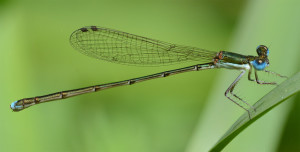
It’s always a pleasure to see these relatively rare damselflies. (Odd, too, how abundance is so tied to locale: Everglades Spite (N. pallidula) is considered very rare, while Southern Sprite isn’t, and yet I get dozens and dozens of the former over several months and very very few of the latter. I guess being near the Everglades is conducive to the occurrence of Everglades Sprite? While most people across the range of these insects are not near the glades…)
When I was finished with the sprite’s photo session I wandered over to the patch of dune sunflower I have growing along the drive. I noticed one flower had two petals sort of curved upward toward each other, indicating, most likely, the presence of a hunting spider. (That is, a spider that hunts without using a web.) It had tied the petals together with a strand of silk; you can see them curling up toward the camera in the photo below:
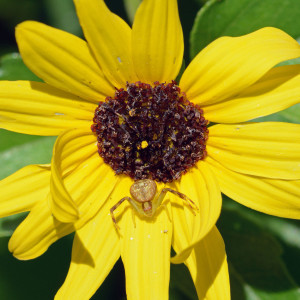
Thomisid spiders are commonly known as “crab spiders” (not to be confused with Gasteracantha cancriformis, commonly known in south Florida as a “crab spider,” although most naturalists call it the spiny-backed orbweaver to avoid confusing it with the “true” crab spiders like the one above).
The true crab spiders are so called because their front pairs of legs are drastically elongated, much like the pincers of a crab. It’s one of the largest spider families, with over 2,000 species worldwide. There are at least 130 species in 9 genera in the United States, so identification to species level is left to the true spider experts, the araneologists (as distinct from the arachnidologists, who study arachnids in general, which includes arthropods from other orders such as scorpions, mites, ticks, and chiggers, in addition to the Daddy Longlegs, which aren’t true spiders at all).
While I was taking pictures of this unusual flower-trapping arrangement (normally I see the petals of the flowers curled down, rather than up), I noticed a wee little lady beetle about to become breakfast:
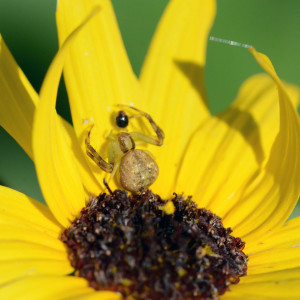
And then the strangest thing happened: the spider just remained motionless while the beetle climbed on the spider’s back, tumbled off onto the disk portion of the flower, and then scurried away out of sight!
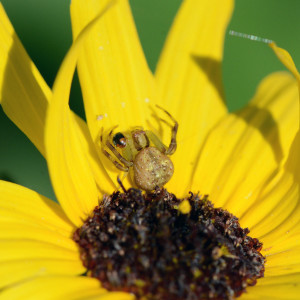
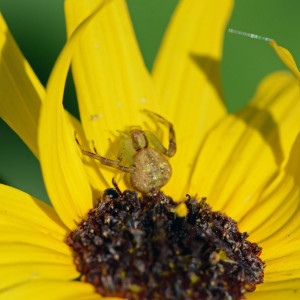
I wasn’t able to snap a picture of the scene as the beetle left, but I was certainly surprised to see what I assumed would be a typical predation scenario turn into nothing at all.
In case you’re curious, the lady beetle looks very much like the “metallic blue” lady beetle, Curinus coeruleus, although it’s by far the smallest one of them I’ve ever seen.
References
Marshall, S., & G.B. Edwards. 2008. Florida’s Fabulous Spiders, 4th ed. Hawaiian Gardens, CA: World Publications.
Ubick, D., P. Paquin, P. E. Cushing, & V. Roth (eds.). 2005. Spiders of North America: An Identification Manual. Keene, NH: American Arachnological Society.
